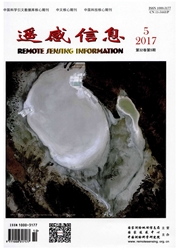

 中文摘要:
中文摘要:
利用2006年8月1日陆地卫星TM数据与7月29日~8月1目的同步湖面采样数据,分析了典型站点反射率光谱特征,建立悬浮物和叶绿素a的反演模型。结果表明悬浮物的变化主要影响TM第2和第4波段,叶绿素a则主要影响TM第3、第4波段。TM4波段与悬浮物具有较高的相关度,利用TM4波段、3×3像元窗口能较好反演出悬浮物浓度。植被指数NDVI((TM4-TM3)/(TM4+TM3))与叶绿素a浓度有较高的相关度,基于5×5像元窗口的植被指数NDVI能很好的反演出太湖叶绿素a浓度,但不能很好地区分出水华和水草。2006年夏季,太湖悬浮物的分布特点为河口区、梅梁湾、西北近岸区最高,其次是湖心区,东太湖、胥口湾和南面的湖州附近湖区浓度最低。叶绿素a分布情况为最高的点出现在梅梁湾口、竺山湾西北部沿岸区以及西太湖近岸区;湖的大部分边缘区即与陆地交接处,叶绿素a的浓度也偏高;南面的湖州附近以及西山岛北面部分湖区叶绿素a浓度最低。而东太湖、胥口湾附近叶绿素a偏高则主要是由该水域沉水植被的发育造成的。
 英文摘要:
英文摘要:
The LANDSAT Thematic Mapper(TM) datas on August 1, 2006 were used together with concurrent measurement of spectral reflectance, total suspended matter (TSM) and chlorophyll-a(Chla) concentration from July 29 to August 1 in Taihu to Lake establish the quantitative retrieval models of TSM and Chla. TM2 and TM4 were affected markedly by TSM, but TM3 and TM4 by Chla. TSM was closely related to TM4 and using 3 by 3 image window; while Chla was closely related to NDVI using 5 by 5 image window. TSM was characterized by regional variation, with the highest value in river inlet, Meiliang Bay, northwest bank of Lake Taihu and the lowest value in East Lake Taihu. However, Chla's highest value was recorded in Meiliang Bay, Zhushan Bay and the lowest value was recorded in the south of the lake. High Chla concentration in East Lake Taihu and Xukou Bay was caused by submerged aquatic vegetation coverage.
 同期刊论文项目
同期刊论文项目
 同项目期刊论文
同项目期刊论文
 A vertically integrated eutrophication model and its application to a river-style reservoir-Fuchunji
A vertically integrated eutrophication model and its application to a river-style reservoir-Fuchunji Characteristics and sources of chromophoric dissolved organic matter in lakes of the Yungui Plateau,
Characteristics and sources of chromophoric dissolved organic matter in lakes of the Yungui Plateau, Controlling harmful cyanobacterial blooms in a hypereutrophic lake (Lake Taihu, China): The need for
Controlling harmful cyanobacterial blooms in a hypereutrophic lake (Lake Taihu, China): The need for Seasonal–spatial variation and remote sensing of phytoplankton absorption in Lake Taihu, a large eut
Seasonal–spatial variation and remote sensing of phytoplankton absorption in Lake Taihu, a large eut The contribution of phytoplankton degradation to chromophoric dissolved organic matter (CDOM) in eut
The contribution of phytoplankton degradation to chromophoric dissolved organic matter (CDOM) in eut Nutrient enrichment and selective predation by zooplankton promote Microcystis (Cyanobacteria) bloom
Nutrient enrichment and selective predation by zooplankton promote Microcystis (Cyanobacteria) bloom Phytoplankton community from Lake Taihu, China, has dissimilar response to inorganic and organic nut
Phytoplankton community from Lake Taihu, China, has dissimilar response to inorganic and organic nut Comparative analysis of nutrients, chlorophyll and transparency in two large shallow lakes (Lake Tai
Comparative analysis of nutrients, chlorophyll and transparency in two large shallow lakes (Lake Tai Modeling remote-sensing reflectance and retrieving chlorophyll-a concentration in extremely turbid C
Modeling remote-sensing reflectance and retrieving chlorophyll-a concentration in extremely turbid C Measured and numerically partitioned phytoplankton spectral absorption coefficient in inland waters.
Measured and numerically partitioned phytoplankton spectral absorption coefficient in inland waters. Bio-optical properties and estimation of the optically active substances in Lake Tianmuhu in summer.
Bio-optical properties and estimation of the optically active substances in Lake Tianmuhu in summer. Comparing sediment bacterial communities in the macrophyte-dominated and the algae-dominated areas o
Comparing sediment bacterial communities in the macrophyte-dominated and the algae-dominated areas o The relationships between nutrients, cyanobacterial toxins and the microbial community in Taihu (Lak
The relationships between nutrients, cyanobacterial toxins and the microbial community in Taihu (Lak A comparison of the size distribution of the filamentous green alga Ulothrix?in Daphnia gut and lake
A comparison of the size distribution of the filamentous green alga Ulothrix?in Daphnia gut and lake Temporal and spatial variations of chemical oxygen demand (COD) in Lake Taihu, China from 2005 to 20
Temporal and spatial variations of chemical oxygen demand (COD) in Lake Taihu, China from 2005 to 20 Dynamics of organic- aggregate- associated bacterial communities and related environmental factors i
Dynamics of organic- aggregate- associated bacterial communities and related environmental factors i 期刊信息
期刊信息
